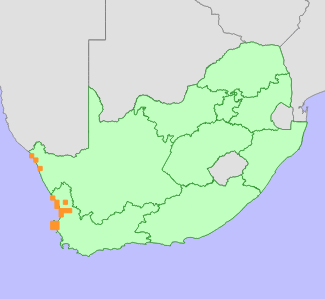|
Scientific Name | Aloe framesii L.Bolus |
Higher Classification | Monocotyledons |
Family | ASPHODELACEAE |
Synonyms | Aloe amoena Pillans, Aloe microstigma Salm-Dyck subsp. framesii (L.Bolus) Glen & D.S.Hardy |
Common Names | Bitter Aloe (e), Bitteraalwyn (a) |
National Status |
Status and Criteria | Near Threatened B1ab(ii,iii,iv) |
Assessment Date | 2018/11/08 |
Assessor(s) | L. von Staden |
Justification | Aloe framesii is a widespread (extent of occurrence 31 464 km²), but rare species. It has been recently recorded at six locations. Intact habitat still remains at four other locations known through historical records, and field surveys are needed to confirm whether it is still present at these sites. It continues to decline due to ongoing habitat loss across its range, and therefore it nearly meets the thresholds for the category Vulnerable under the criteria B1ab. |
Distribution |
Endemism | South African endemic |
Provincial distribution | Northern Cape, Western Cape |
Range | This species is endemic to the Northern Cape and Western Cape provinces of South Africa, where it occurs along the West Coast from Port Nolloth to Saldanha Bay. |
Habitat and Ecology |
Major system | Terrestrial |
Major habitats | Namaqualand Coastal Duneveld, Namaqualand Strandveld, Southern Richtersveld Yellow Duneveld, Namaqualand Heuweltjie Strandveld, Richtersveld Coastal Duneveld, Citrusdal Vygieveld, Vanrhynsdorp Gannabosveld, Saldanha Flats Strandveld, Saldanha Granite Strandveld, Lambert's Bay Strandveld |
Description | It occurs in flat, sandy areas on coastal lowlands. |
Threats |
| Aloe framesii is threatened by mining, agriculture and coastal development. Between the Hol River and Port Nolloth, as well as around Brand-se-Baai, Vanrhynsdorp and Kleinsee, Aloe framesii is threatened by ongoing habitat loss to severely destructive open cast mining of mineral rich sand dunes.
Further south along the coast, subpopulations are declining due to ongoing habitat loss to coastal development. At St Helena Bay, a subpopulation recorded in 2016 is about to be lost to coastal development, while a subpopulation at Doringbaai was recorded in an Environmental Impact Assessment for a housing development in 2006.
Between Lambert's Bay and Clanwilliam, there is ongoing habitat loss to potato and rooibos tea cultivation. The species was last recorded in this area in 1938, and it may be locally extinct here. |
Population |
A. framesii is not well known and may be more common than collection records indicate - particularly in the northern part of its range which remains botanically poorly explored. Van Wyk and Smith (1996, 2003) do not consider the species threatened. However, most of the known locations are in highly transformed areas as well as in areas of actively expanding mining, and from these threats a continuing population decline is inferred. Reynolds (1969) do not indicate whether this species is common or not, and mentions only a few observed sites, which may indicate that the occurrence is somewhat more sporadic than other Aloe species.
|
Population trend | Decreasing |
Assessment History |
Taxon assessed |
Status and Criteria |
Citation/Red List version | | Aloe framesii L.Bolus | NT B1ab(ii,iii,iv) | 2015.1 | | Aloe microstigma Salm-Dyck subsp. framesii (L.Bolus) Glen & D.S.Hardy | NT B1ab(ii,iii,iv) | Raimondo et al. (2009) | |
Bibliography |
Glen, H.F. and Hardy, D.S. 2000. Aloaceae (First part): Aloe. In: G. Germishuizen (ed). Flora of Southern Africa 5 Part 1, Fascicle 1:1-159. National Botanical Institute, Pretoria.
Klopper, R.R. and Smith, G.F. 2007. The genus Aloe (Asphodelaceae: Alooideae) in Namaqualand, South Africa. Haseltonia 13:38-51.
Manning, J.C. and Goldblatt, P. 2012. Plants of the Greater Cape Floristic Region 1: The Core Cape Flora. Strelitzia 29. South African National Biodiversity Institute, Pretoria.
Raimondo, D., von Staden, L., Foden, W., Victor, J.E., Helme, N.A., Turner, R.C., Kamundi, D.A. and Manyama, P.A. 2009. Red List of South African Plants. Strelitzia 25. South African National Biodiversity Institute, Pretoria.
Reynolds, G.W. 1969. The Aloes of South Africa. A.A. Balkema, Cape Town.
Snijman, D.A. 2013. Plants of the Greater Cape Floristic Region 2: The extra Cape flora. Strelitzia 30. South African National Biodiversity Institute, Pretoria.
Van Wyk, B.-E. and Smith, G. 1996. Guide to the aloes of South Africa. Briza Publications, Pretoria.
|
Citation |
| von Staden, L. 2018. Aloe framesii L.Bolus. National Assessment: Red List of South African Plants version . Accessed on 2025/05/19 |
 Comment on this assessment
Comment on this assessment

